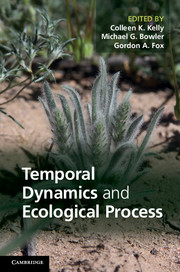Book contents
- Frontmatter
- Contents
- List of Contributors
- 1 Introduction
- Part I Observing temporal processes in nature
- Part II Application to specific questions
- 9 Evolution of synchronised and intermittent reproduction (masting) of trees: key role of regeneration dynamics
- 10 Spatiotemporal variation can promote coexistence more strongly than temporal variation
- 11 Roles of pollinator attraction and environmental fluctuation in inducing flowering synchrony
- 12 Temporal dynamics and the spread of insect resistance transgenes
- 13 Concluding remarks
- Index
- References
13 - Concluding remarks
Published online by Cambridge University Press: 18 December 2013
- Frontmatter
- Contents
- List of Contributors
- 1 Introduction
- Part I Observing temporal processes in nature
- Part II Application to specific questions
- 9 Evolution of synchronised and intermittent reproduction (masting) of trees: key role of regeneration dynamics
- 10 Spatiotemporal variation can promote coexistence more strongly than temporal variation
- 11 Roles of pollinator attraction and environmental fluctuation in inducing flowering synchrony
- 12 Temporal dynamics and the spread of insect resistance transgenes
- 13 Concluding remarks
- Index
- References
Summary
Niche dynamics
The chapters in this volume convey several important messages. Perhaps the most obvious of these is that there is mounting – and compelling – empirical evidence for the importance of temporal niche differentiation in natural communities. The contributions by Adler, Chesson et al., Fowler and Pease, Hanley and Sykes, Kelly et al. and Venable and Kimball provide strong evidence that temporal niche differentiation occurs, that it can be documented and that in at least some cases we can understand many of its mechanistic underpinnings. While there is still much to be learned, these contributions – together with earlier published work (see citations in chapters) – have established the temporal niche as a vital area of research and built a foundation for the study of temporal processes in nature.
It is essential to the better understanding of temporal process that empirical evidence continues to be developed, and with a variety of approaches. For many ecologists, temporal niches (and differentiation between them among competing species) represent something new to the way we have been accustomed to think and to conduct research. Persuading ecologists that this is an important area of research (and that temporal niche differentiation is an important part of species coexistence) is likely to require more than a single book or critical experiment, but here we present a considerable body of evidence developed in a variety of communities, using multiple approaches to make inferences.
- Type
- Chapter
- Information
- Temporal Dynamics and Ecological Process , pp. 309 - 320Publisher: Cambridge University PressPrint publication year: 2014



